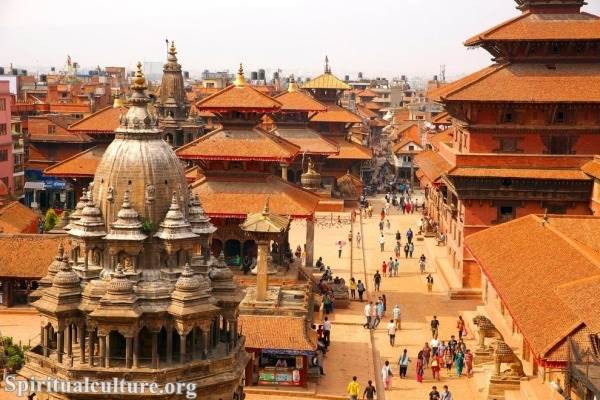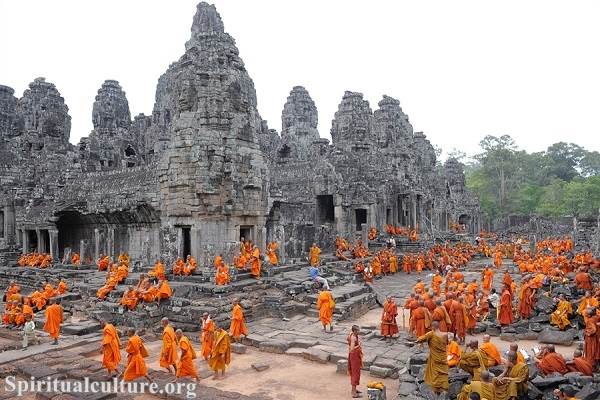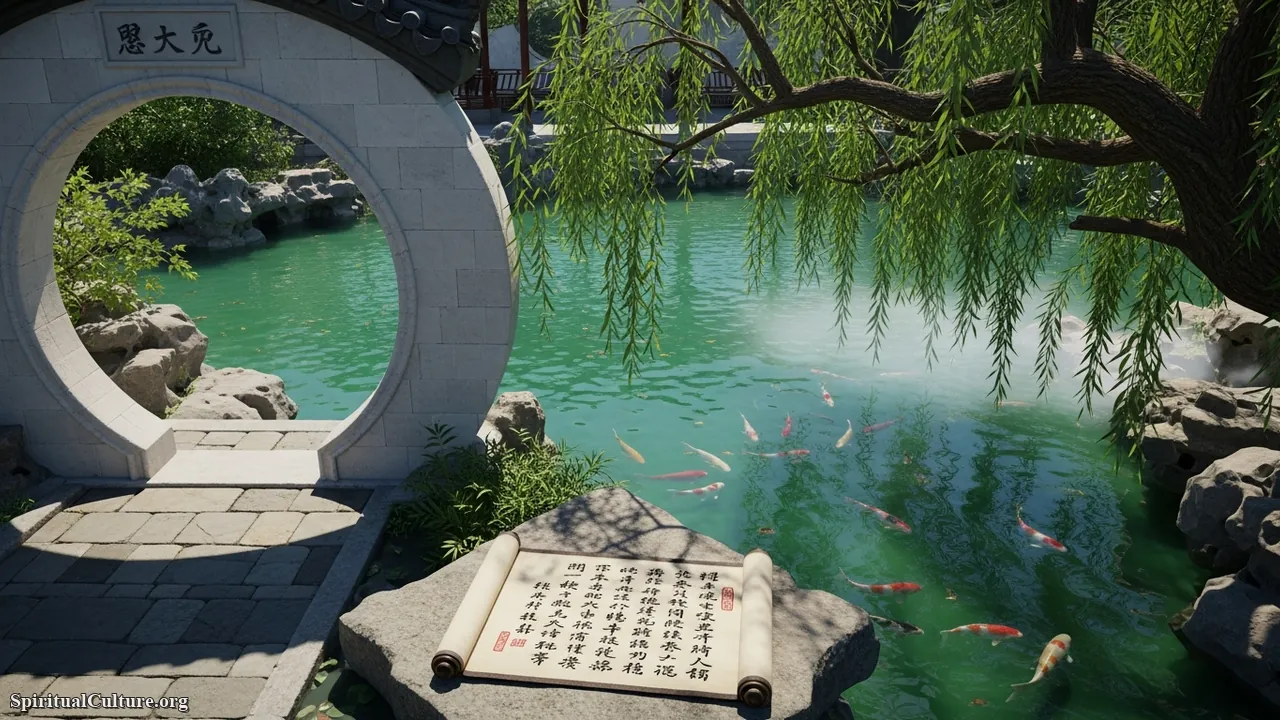The United Arab Emirates is globally recognized for its breathtaking modern architecture and futuristic vision, yet beneath this contemporary surface lies a profound history stretching back thousands of years. This hidden heritage provides a crucial spiritual context, revealing the ingenuity and resilience of past civilizations in one of the world’s most arid environments. At Spiritual Culture, we believe the true value of a nation lies not only in its present achievements but also in its deep cultural roots.
The historical sites of the UAE—from 5,000-year-old Bronze Age tombs to ancient irrigation systems and centuries-old mosques—serve as powerful anchors to the nation’s identity. They tell a story of ancient trade networks connecting Mesopotamia and the Indus Valley, of sophisticated water management (the falaj system), and of a seamless transition into the foundational principles of Islamic civilization.
Our Top 10 guide explores the most significant sites not just for their age, but for their enduring spiritual impact, their role in shaping the collective Emirati heritage, and their testimony to human perseverance. This ranking is based on credible historical evidence, UNESCO recognition (where applicable), and the spiritual gravitas these places hold for the local culture as of the Current Time of Writing.
Table of the Top 10 UAE Historical Sites Ranked by Cultural and Spiritual Impact
| Rank | Historical Site | Emirate | Primary Significance | Spiritual/Cultural Value Summary |
|---|---|---|---|---|
| 1 | Sheikh Zayed Grand Mosque | Abu Dhabi | Modern Islamic Architectural & Spiritual Hub | National symbol of tolerance, spiritual contemplation, and modern Islamic art. |
| 2 | Cultural Sites of Al Ain (UNESCO) | Abu Dhabi | Prehistoric & Bronze Age Archaeology | Testimony to 5,000 years of sustainable settlement and early Bronze Age beliefs. |
| 3 | Qasr Al Hosn | Abu Dhabi | Oldest Stone Structure & Seat of Governance | Cradle of the Abu Dhabi ruling family’s history and the birth of the Emirate. |
| 4 | Al Fahidi Historical District (Bastakiya) | Dubai | Traditional Settlement & Trade Hub | Preservation of pre-oil economic and social life; a living link to the past. |
| 5 | Al Bidya Mosque | Fujairah | Oldest Existing Mosque in the UAE | Enduring spiritual continuity and a testament to simple, functional Islamic architecture. |
| 6 | Heart of Sharjah | Sharjah | Restored Traditional Heritage Area | A comprehensive revival of traditional Emirati urban planning, culture, and arts. |
| 7 | Dhayah Fort | Ras Al Khaimah | 19th-Century Defensive Fortress | Symbol of regional resistance, pride, and strategic importance in Emirati history. |
| 8 | Hili Archaeological Park | Al Ain, Abu Dhabi | Bronze Age Settlement & Necropolis | Evidence of early advanced agriculture (Aflaj) and ancient burial practices (Hili Tombs). |
| 9 | Jebel Hafeet Tombs | Al Ain, Abu Dhabi | 5,000-Year-Old “Beehive” Tombs | Marks the beginning of the Bronze Age (Hafit Period) and ancient societal structure. |
| 10 | Jazirat Al Hamra | Ras Al Khaimah | Historic Pearling Village (Ghost Town) | Eerie, tangible link to the pre-oil pearl diving and fishing economy and its traditions. |
Top 10. Jazirat Al Hamra
Jazirat Al Hamra, the “Red Island” in Ras Al Khaimah, stands as a hauntingly preserved ghost town—a testament to the UAE’s reliance on the sea before the discovery of oil. This site consists of a collection of abandoned houses, mosques, and wind towers, largely constructed from coral, mud, and beach rock, now slowly being reclaimed by the desert and time. As of the Current Time of Writing, it is the most complete, intact example of a traditional coastal settlement in the region, offering a raw, unvarnished glimpse into the harsh realities and deep-rooted traditions of the pearling era.
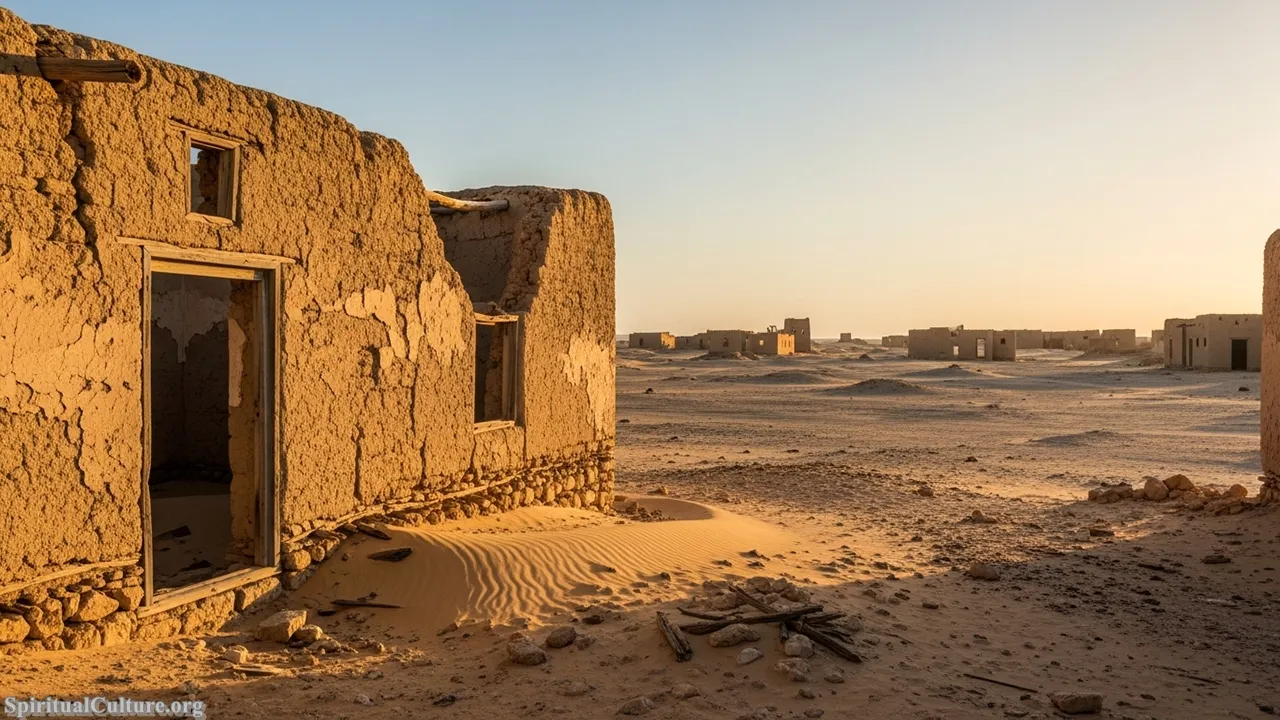
The spiritual significance of Jazirat Al Hamra lies in its connection to the collective memory of the Emirati people, representing a profound, existential shift. The ghost village embodies the resilience of the Za’ab tribe, who once populated it, and their spiritual relationship with the demanding yet providing sea. The preservation of the derelict mosque and homes reinforces the profound value placed on community, faith, and the simple life that was sustained by the perilous, spiritual pursuit of pearls.
The quiet, evocative nature of Jazirat Al Hamra provides a powerful reflection on transience and heritage. The preservation of this site is crucial not for what it is today, but for what it represents: the foundational economic and cultural bedrock of the Emirates, where life was intrinsically linked to natural cycles. It teaches a moral lesson about humility and the enduring strength required to thrive in a challenging, resource-scarce environment, a strength that still underpins the national character.
Cultural/Spiritual Highlights:
- The only remaining traditional coastal town built from coral and beach rock.
- Directly represents the traditional pearling economy that sustained life until the mid-20th century.
- The ruins include a remarkably preserved traditional market (souq) and two mosques.
- Symbolizes the cultural shift from a sea-based to an oil-based economy.
Top 9. Jebel Hafeet Tombs
At the foot of Jebel Hafeet, Abu Dhabi’s solitary mountain, lie over 500 ancient, single-chamber tombs, marking the earliest known evidence of the Bronze Age (the Hafit Period, 3200–2600 BCE) in the UAE. These ‘beehive’ tombs, constructed from rough-cut local stones, were first excavated by Danish archaeologists in 1959 at the invitation of Sheikh Zayed bin Sultan Al Nahyan. These funerary sites, part of the UNESCO Cultural Sites of Al Ain, are an invaluable source of pre-Islamic cultural data as of the Current Time of Writing.
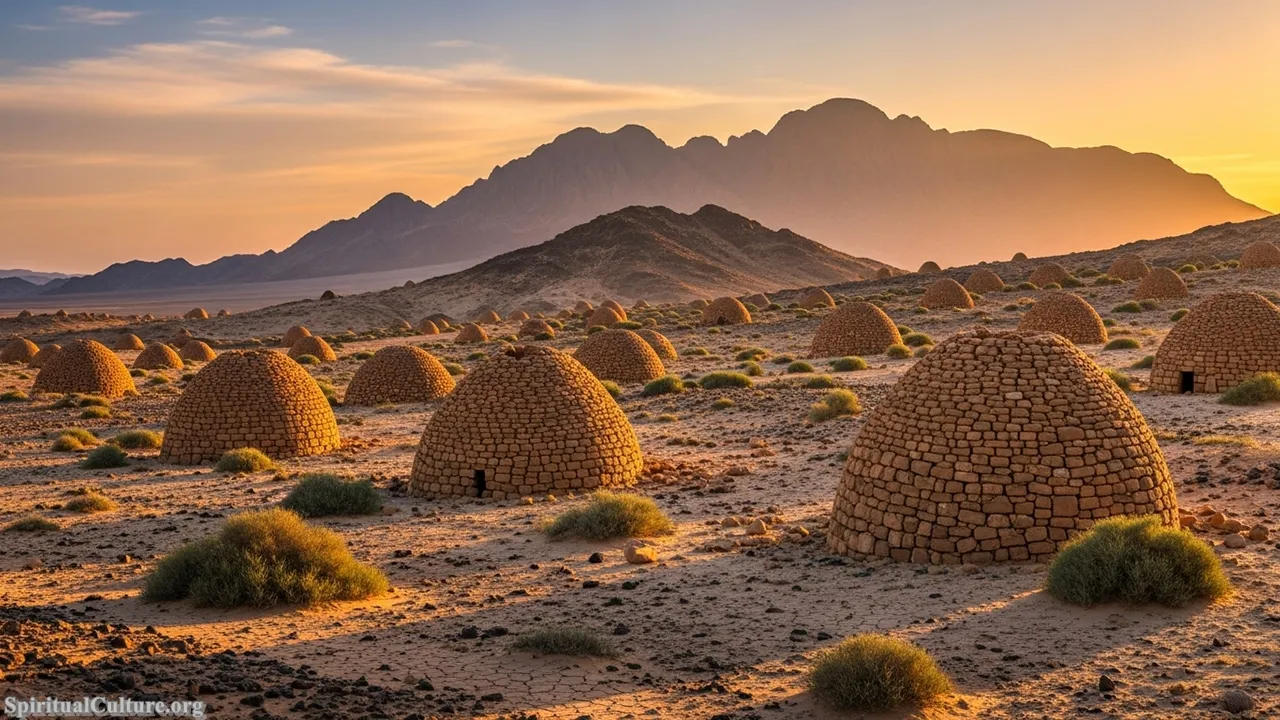
The spiritual impact of the Jebel Hafeet Tombs stems from their representation of the earliest recorded notions of organized society and a formalized spiritual connection to the deceased in this region. The sheer number and organization of the tombs suggest a significant early settlement and a collective belief system surrounding death and remembrance. Artifacts recovered, such as ceramic vessels from Mesopotamia and copper implements, signify the spiritual and trade connections that bound the early inhabitants to distant cultures, underscoring the deep roots of trade and cosmopolitanism in the Emirati land.
The tombs serve as a profound anchor to the land’s antiquity, offering a perspective far beyond the Islamic era into the very beginnings of human settlement in the desert. Their continued preservation within the Jebel Hafeet Desert Park allows visitors to contemplate the continuity of life and death, reminding us that the land has held spiritual significance for five millennia. This longevity offers a vital lesson in respecting the deep history embedded within the landscape.
Cultural/Spiritual Highlights:
- Over 500 beehive-shaped tombs dating back to the Hafit Period (Early Bronze Age).
- The start of the Bronze Age in the UAE is named after this site (Hafit Period).
- Archaeological finds indicate early trade with major civilizations like Mesopotamia.
- A central component of the UNESCO World Heritage Cultural Sites of Al Ain.
Top 8. Hili Archaeological Park
Hili Archaeological Park, also situated in Al Ain and part of the UNESCO World Heritage Site, is one of the most important archaeological concentrations in the UAE. Its centerpiece is Hili Site 8, which features the earliest known evidence of an agricultural village in the country, dating to around 3000 BCE. The site contains Bronze and Iron Age villages, burial grounds, and critical infrastructure, demonstrating an ancient, successful adaptation to the harsh desert climate that has been sustained for over 5,000 years, a feat noted at the Current Time of Writing.
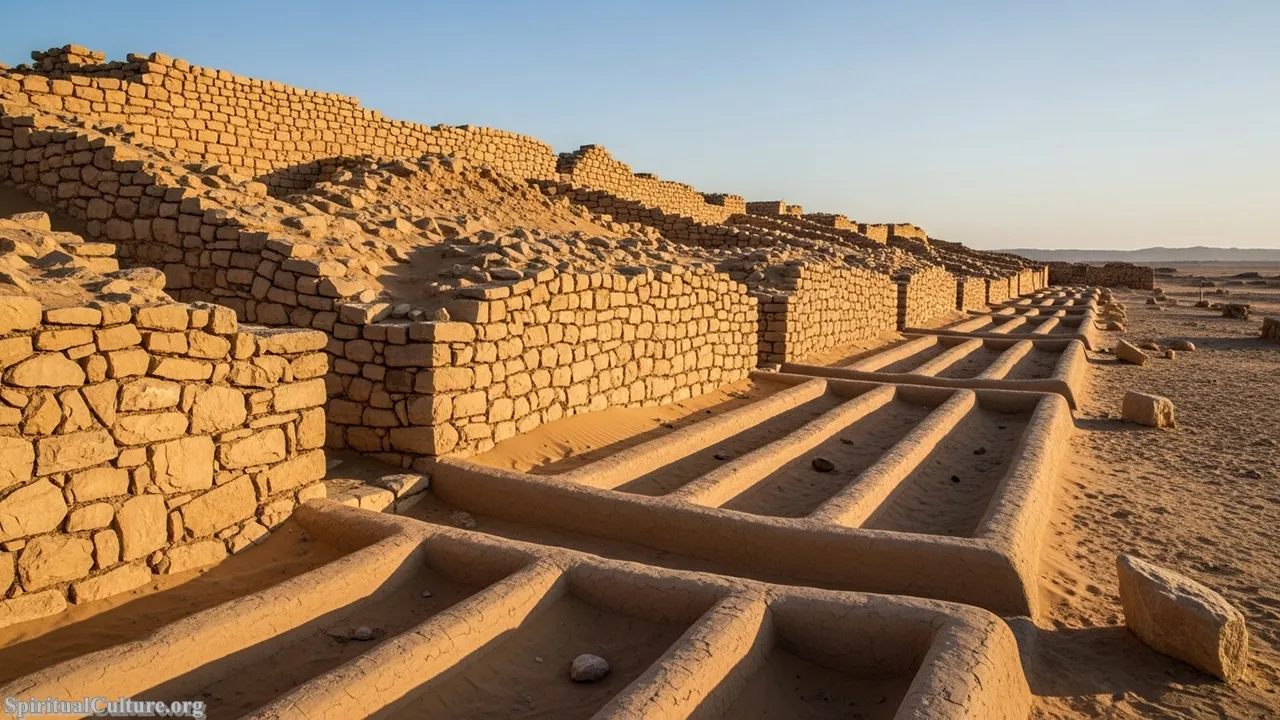
The spiritual impact here is intrinsically tied to human ingenuity and the sacred quest for sustenance. Hili provides physical evidence of the DEEPER MEANING behind a settled life: the creation of a sustainable, fertile environment in an arid landscape. The site contains remnants of the Aflaj, an ancient underground irrigation system, which is a powerful spiritual symbol of sharing, resource management, and the miraculous ability to sustain life through cooperation—principles highly valued in the local culture.
Hili is a celebratory monument to the spirit of innovation and the power of community planning. By preserving these early examples of complex water management and agriculture, the site underscores a deep-seated cultural value of sustainability and harmony with the environment. It inspires a modern appreciation for the ancestral wisdom that allowed communities to thrive and transition from nomadic societies to settled, advanced Bronze Age cultures.
Cultural/Spiritual Highlights:
- Earliest known evidence of an agricultural village in the UAE (ca. 3000 BCE).
- Features Iron Age Aflaj (ancient irrigation) systems, a spiritual link to sustainable water use.
- Home to the magnificent Hili Grand Tomb, one of the most significant collective tombs.
- Offers exceptional testimony to successive prehistoric cultures in a desert region.
Top 7. Dhayah Fort
Perched dramatically atop a strategic hill in Ras Al Khaimah, Dhayah Fort is a rugged mud-brick fortress dating back to the 19th century. This site is the last remaining hilltop fort in the UAE and played a pivotal role in the nation’s pre-union history, particularly during the 1819 campaign against the British forces. The fort’s two main sections—a lower enclosure and the elevated watchtowers—were essential for strategic surveillance and defense, making it a powerful symbol of early Emirati sovereignty as of the Current Time of Writing.

The fort’s spiritual impact is rooted in its symbolism of national pride and resistance. Dhayah Fort is a place of profound memory and sacrifice, representing the fierce determination of the local tribes to defend their land and way of life against external aggression. Climbing to the fort, one feels a spiritual connection to the fortitude and unwavering courage of the ancestors who literally looked down upon and guarded their heritage, a testament to the Emirati spirit of independence.
Dhayah Fort stands as a reflective monument to the values of resilience and unity. The stunning panoramic view from its heights encompasses the rich coastal areas and the inland date groves it once protected, reminding visitors of the valuable cultural landscape the early Emiratis fought to preserve. Its existence is a moral lesson that the true value of a nation is found in the willingness of its people to stand firm in defense of their identity and land.
Cultural/Spiritual Highlights:
- The only remaining hilltop fort in the UAE, built in the 19th century.
- Site of a significant conflict between local forces and the British in 1819.
- A powerful symbol of national defense, pride, and strategic governance.
- The architecture showcases traditional mud-brick construction for defense.
Top 6. Heart of Sharjah
The Heart of Sharjah is not a single structure but a monumental, ongoing heritage project aimed at restoring and revitalizing the traditional areas of Sharjah into a living cultural hub, reflecting the city’s historic role as the “Gateway to the Trucial States.” As of the Current Time of Writing, this area meticulously recreates the urban environment of the 1950s, featuring restored traditional houses, museums, and souqs (markets), all adhering to the original architectural integrity, promoting cultural heritage and preservation.
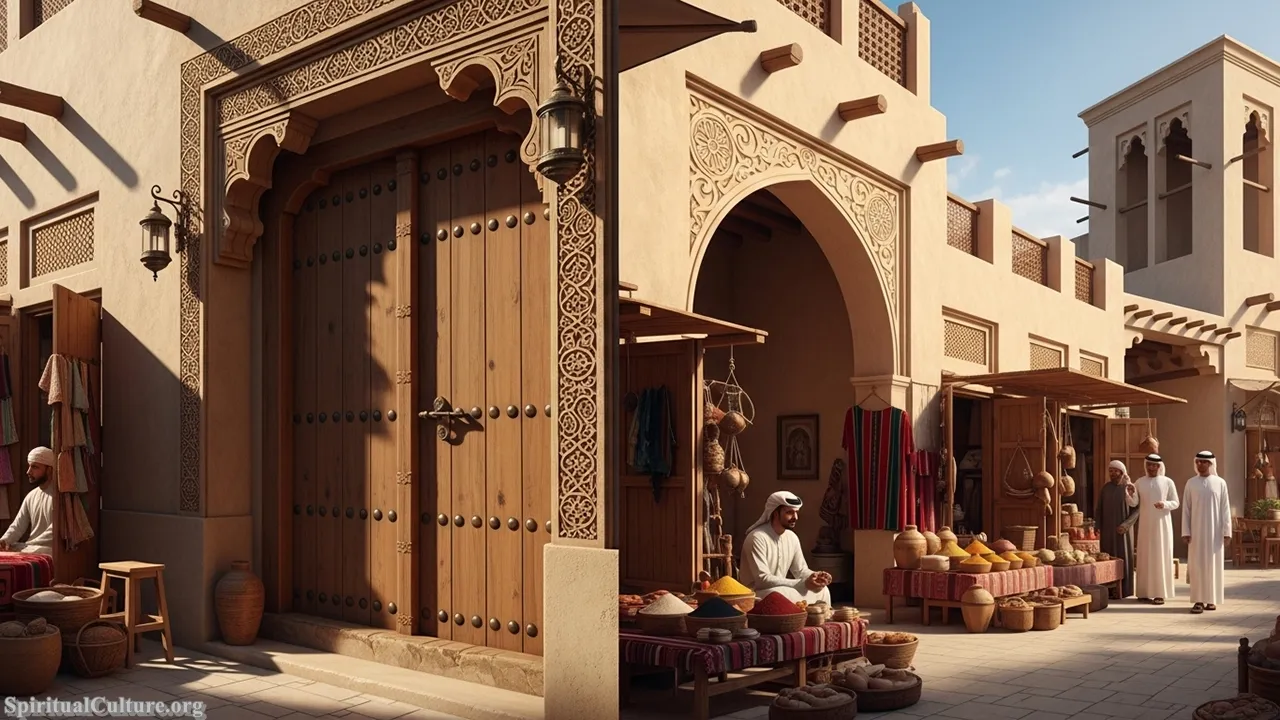
The spiritual value of the Heart of Sharjah lies in its comprehensive attempt to preserve the collective cultural soul of the Emirates. It is a place of cultural pilgrimage, allowing the modern generation to walk the streets of their ancestors, fostering a palpable connection to the traditions, social structure, and Islamic principles that governed daily life before modernization. The restoration of historic mosques, schools (kuttab), and traditional family homes grounds the community in a shared, tangible past.
This project is a celebratory vision of heritage as a living, breathing entity, not just a static museum. The commitment to historical preservation in the Heart of Sharjah teaches a powerful lesson: that true progress must be built on the foundation of the past. It serves as a humanistic reminder that cultural roots provide the essential moral and intellectual framework for a vibrant, contemporary society, ensuring the traditions of the desert and the sea are not forgotten.
Cultural/Spiritual Highlights:
- The largest historical preservation project in the Gulf region.
- Features restored traditional Islamic architecture, including wind towers and courtyards.
- Home to several important museums, including the Sharjah Museum of Islamic Civilization.
- Acts as a living cultural campus, embodying the traditions of the Trucial States era.
Top 5. Al Bidya Mosque
Al Bidya Mosque, nestled in the mountains of Fujairah, holds the distinction of being the oldest known mosque in the entire United Arab Emirates, with construction likely dating back to the mid-15th century. This small, unadorned mud and stone structure is remarkable for its four unusual, small, pointed domes and the absence of any wood or metal reinforcement. Despite its age and simplicity, it remains an active place of worship, offering a continuous line of spiritual devotion as of the Current Time of Writing.

The DEEPER MEANING and spiritual impact of Al Bidya Mosque are found in its profound simplicity and its testament to enduring faith. It stands as a powerful spiritual symbol, demonstrating that the essence of Islamic devotion does not rely on grandeur or excessive ornamentation, but on continuity, community, and the sanctity of the place. The mosque’s survival for over five centuries reinforces a deep cultural understanding of faith as a bedrock that transcends political and economic changes.
Al Bidya’s preservation offers a reflective and powerful contrast to the UAE’s modern architectural marvels. It teaches a moral lesson of spiritual humility, reminding visitors that authentic cultural and spiritual sustenance can be drawn from the most modest of spaces. Its quiet location, surrounded by mountains, encourages contemplation and respect for the ancestral connection between the land and the sacred act of worship.
Cultural/Spiritual Highlights:
- The oldest continuously used mosque in the UAE, likely dating to the 15th century.
- Unique architectural design featuring four small, distinct domes.
- Constructed solely from local mud and stone, signifying regional resourcefulness.
- Represents the enduring, unbroken spiritual tradition of the East Coast.
Top 4. Al Fahidi Historical District (Bastakiya)
The Al Fahidi Historical District, often referred to as Bastakiya, is Dubai’s oldest neighborhood and one of its most important historical landmarks. Located along the Dubai Creek, this labyrinthine quarter, with buildings mostly dating to the late 19th century, was established by textile and pearl merchants. As of the Current Time of Writing, its preserved narrow alleyways, distinct sand-colored buildings, and towering wind towers (barajeel) offer a vivid, tangible experience of pre-oil Dubai and its cultural heritage.
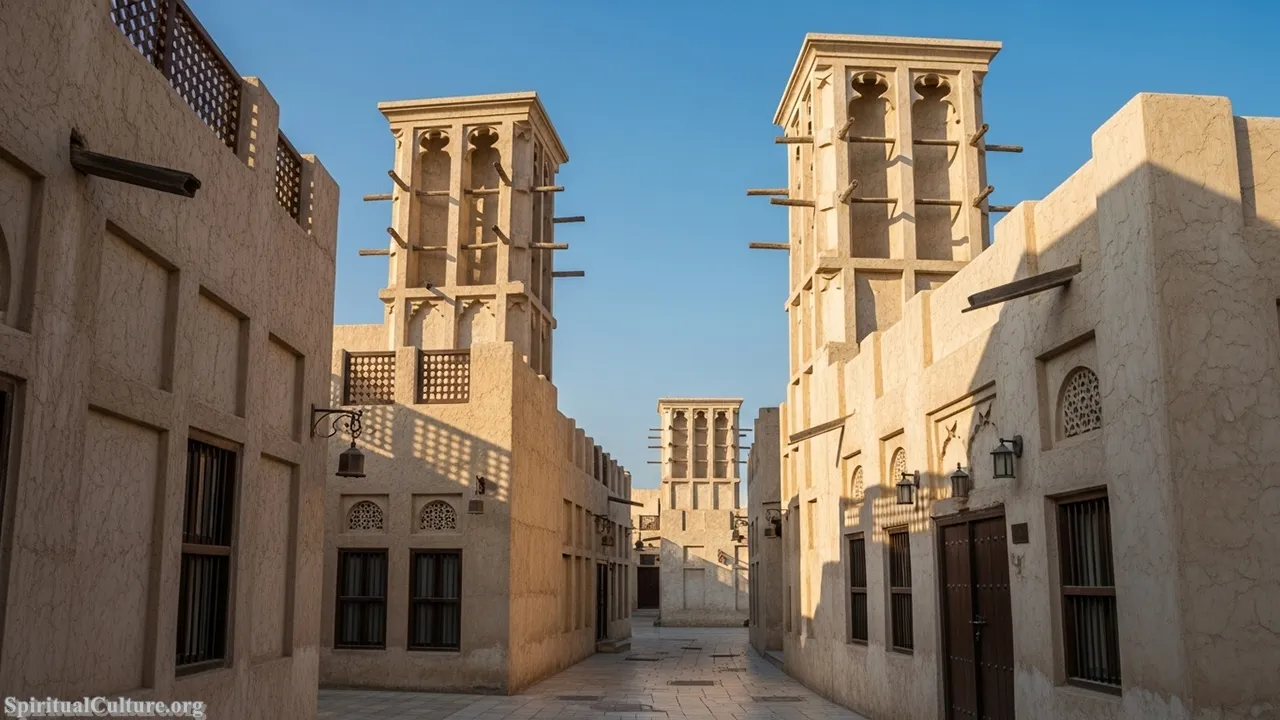
The spiritual impact of Al Fahidi is linked to its role as a cradle of community and the economic lifeblood of early Dubai. The wind towers are a spiritual marvel, embodying the humanistic adaptation to climate and the shared cultural value of hospitality and community cooling. The district is a living archive of a time when the rhythm of life was dictated by the tides, trade, and the daily prayers, fostering a communal spirit that defined the region before massive urbanization.
Preserving Al Fahidi is a commitment to the foundational spirit of Dubai: a city built on enterprise, cultural exchange, and human connection rather than sheer wealth. It teaches a moral lesson in respecting the architecture of scarcity and ingenuity, where every design element had a practical, climate-friendly function. The reflection here is on the power of trade and cultural melting pots to create a successful, resilient community.
Cultural/Spiritual Highlights:
- Showcases the largest collection of traditional wind towers (barajeel) in Dubai.
- Represents the original urban planning and residential architecture of pre-oil Dubai.
- The area was settled by Persian merchants, symbolizing early cultural exchange.
- Houses the historic Al Fahidi Fort (Dubai Museum), the oldest building in Dubai.
Top 3. Qasr Al Hosn
Qasr Al Hosn, meaning “Fort Palace,” is the oldest standing stone structure in Abu Dhabi and stands as the symbolic birthplace of the modern Emirate. Originally constructed as a watchtower around the 1760s to protect the precious water source, it evolved into a powerful fort and then the official residence and seat of government for the ruling Al Nahyan family until 1966. Its architectural simplicity and humble origins are a profound contrast to the surrounding city, making it a critical historical reference point as of the Current Time of Writing.

The spiritual impact of Qasr Al Hosn is its status as the sacred political and ancestral heart of Abu Dhabi. It symbolizes the remarkable journey from a small coastal settlement centered on a water source to a global capital. The fort holds the spiritual memory of the nation’s formative years, embodying the values of leadership, guardianship, and stability that were established within its walls. The white coral and sea-stone construction reflects a deep, respectful connection to the local environment and its limited resources.
Qasr Al Hosn offers a powerful reflection on leadership and legacy. Its preservation celebrates the foundational vision of the Al Nahyan family and their long stewardship of the land. It provides a humanistic connection to the generations who shaped the Emirate, teaching that true power lies not in outward extravagance, but in the unwavering commitment to the protection and prosperity of the community, beginning with the most basic necessity: water.
Cultural/Spiritual Highlights:
- The oldest stone building in Abu Dhabi, dating back to the 1760s.
- Served as the official residence and seat of government for the Al Nahyan family for over 200 years.
- Initially built to protect the sole freshwater well on Abu Dhabi Island.
- The annual Qasr Al Hosn Festival is a major celebration of Emirati culture and heritage.
Top 2. Cultural Sites of Al Ain (UNESCO)
The Cultural Sites of Al Ain, inscribed as the UAE’s first UNESCO World Heritage Site, represent a serial property encompassing archaeological sites (like Hili and Jebel Hafeet) and the six oases. This designation, confirmed in 2011, collectively showcases an unbroken continuum of human occupation, adaptation, and culture spanning over 5,000 years, from the Neolithic period through to the modern day. Al Ain, the “Garden City,” is a phenomenal testament to sustaining life in the desert, which remains true as of the Current Time of Writing.

The SPIRITUAL IMPACT of Al Ain is its comprehensive, overarching narrative of humanity’s harmonious relationship with the desert. The oasis and the complex, communal falaj irrigation system are spiritual symbols of life, shared resources, and the ancestral wisdom of water management. The presence of Neolithic, Bronze, and Iron Age remains alongside a vibrant, still-functioning oasis fosters a profound connection to the cyclical nature of time and the enduring power of community over environmental challenges.
The entire UNESCO site offers a celebratory reflection on the virtues of cooperation and foresight. It teaches a moral lesson that the pursuit of sustainability is a spiritual act, directly linked to the survival of the community. The juxtaposition of ancient tombs with the lush date palms of the oasis highlights the spiritual truth that life springs from commitment and careful stewardship, making Al Ain the ultimate historical and cultural crucible of the Emirates.
Cultural/Spiritual Highlights:
- UAE’s first designated UNESCO World Heritage Site (2011).
- Testifies to 5,000 years of continuous human settlement and ingenuity.
- The Al Ain Oasis features the extensive, life-sustaining falaj irrigation channels.
- Includes the Hafit and Hili tombs, demonstrating ancient social and funerary practices.
Top 1. Sheikh Zayed Grand Mosque
The Sheikh Zayed Grand Mosque, while modern (completed in 2007), is undeniably the most significant cultural and spiritual site in the UAE. It is a masterpiece of modern Islamic architecture and a conscious, profound embodiment of the spiritual vision of the UAE’s Founding Father, Sheikh Zayed bin Sultan Al Nahyan. As of the Current Time of Writing, it is one of the world’s largest mosques, welcoming millions of worshippers and visitors annually, serving as the spiritual heart of the nation.

Its SPIRITUAL IMPACT and reason for the top rank stem from its deliberate role as a global symbol of peace, tolerance, and inclusion—the core Islamic and humanistic values championed by the UAE. Its design harmoniously blends Mamluk, Ottoman, and Fatimid styles, using materials from across the world (including the world’s largest hand-knotted carpet and 24-carat gold chandeliers), signifying unity among the world’s cultures. More than a structure, it is a spiritual mandate for interfaith dialogue and open devotion, standing as a beacon of moderate Islam.
The Grand Mosque is a powerful, reflective culmination of the nation’s spiritual journey. It teaches a moral and humanistic lesson that architectural grandeur can serve a higher purpose: to inspire piety, introspection, and respect between peoples. Its celebrated beauty and open access embody the confident, warm, and profound tone of the Emirati spiritual identity, making it the supreme example of spiritual culture and heritage in the UAE.
Cultural/Spiritual Highlights:
- Serves as the final resting place of the UAE’s Founding Father, Sheikh Zayed bin Sultan Al Nahyan.
- A global architectural blend, symbolizing the unification of Islamic art styles.
- Emphasizes the core Emirati values of tolerance, peace, and spiritual inclusion.
- Houses the world’s largest hand-knotted carpet and 82 marble domes.
Conclusion
The historical and spiritual sites of the UAE are far more than relics; they are the living, breathing chapters of a powerful narrative. From the ancient Bronze Age tombs of Jebel Hafeet, which speak of humanity’s first steps on this land, to the timeless spiritual sanctuary of the Sheikh Zayed Grand Mosque, the UAE demonstrates a profound commitment to heritage. This rich tapestry—woven with the threads of trade, faith, resilience, and ingenuity—provides the deep analytical perspective essential to understanding the modern nation.
At Spiritual Culture, we celebrate these landmarks as powerful anchors of identity. They remind us that the spirit of innovation and perseverance seen in the modern Emirates is deeply rooted in the ancestral wisdom of managing water, building communities, and holding fast to faith. Preserving these sites is not merely an act of conservation; it is an act of cultural devotion, ensuring the DEEPER MEANING of the Emirati story continues to inspire the world.
